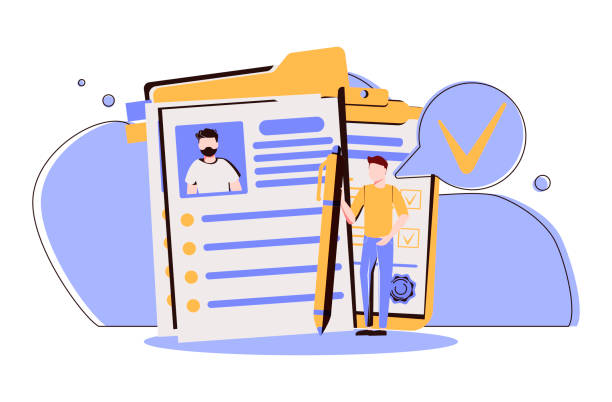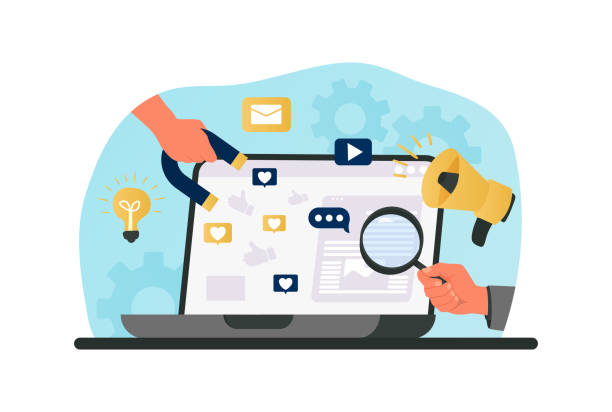Introduction to Secure Website Design and Its Importance

In today’s digital world, which is growing in complexity and scope every day, #Secure_Website_Design is not just a competitive advantage, but a #Critical_Necessity.
Your website is the storefront of your business and your online identity, so #Protecting_It from cyber threats is of paramount importance.
A #Secure_Website attracts user trust and protects sensitive customer data and your business information.
Ignoring this can lead to data loss, reputational damage, and even severe legal penalties.
The concept of secure website design includes a set of methods, technologies, and policies used to prevent unauthorized access, alteration or destruction of data, and disruption of site functionality.
This process begins from the initial stages of design and development and continues through ongoing maintenance and updates.
In this article, we will examine various aspects of this topic to give you a comprehensive understanding of how to implement a secure website.
This basic explanatory and educational section highlights the importance of cybersecurity in the web environment and sets the stage for more specialized discussions.
Protecting user information and service stability are two main pillars of any secure website design.
Losing potential customers due to an unprofessional website? Rasaweb is your answer! With our specialized corporate website design services:
✅ Enhance your business’s credibility and standing
✅ Experience attracting more targeted customers
⚡ Act now to receive a free consultation!
Common Web Security Threats and Countermeasures

With the ever-growing online space, cyber attackers have also devised new and more complex methods to penetrate systems.
Understanding these threats is the first step towards secure website design and strengthening your website’s defensive foundations.
Among the most common attacks is SQL Injection, which allows an attacker to gain control of the database by inserting malicious code into input fields.
The solution to this problem is to use parameterized queries and strict input validation.
XSS (Cross-Site Scripting) attacks also steal user information by injecting malicious JavaScript code into web pages; combating them requires output encoding and using Content Security Policies (CSP).
CSRF (Cross-Site Request Forgery) enables an attacker to force a user to perform unintended actions; anti-CSRF tokens and checking HTTP headers can prevent these attacks.
Brute Force attacks to guess passwords and DDoS attacks to disrupt services by flooding them with traffic are also considered serious threats.
To counter these, the use of Intrusion Detection Systems (IDS), Web Application Firewalls (WAF), and the implementation of strong password policies are essential.
Thorough understanding of these vulnerabilities and implementation of specialized solutions are an inseparable part of a secure and stable website design.
Any negligence in this area can lead to disaster.
Principles of Cryptography and Security Protocols in Web Design

Cryptography is the backbone of data security in the online world and plays a vital role in secure website design.
This process transforms information in such a way that only authorized individuals can read and understand it.
The HTTPS (Hypertext Transfer Protocol Secure) protocol is the prominent symbol of this security on the web.
HTTPS encrypts the communication between the user’s browser and the website server using SSL (Secure Sockets Layer) or TLS (Transport Layer Security) layers.
This encryption ensures that data remains safe from unauthorized access, eavesdropping, or tampering during transmission.
Implementing SSL/TLS is not only crucial for the security of sensitive data like credit card information or passwords, but it also positively impacts the website’s credibility and search engine ranking.
SSL certificates come in various types, from Domain Validation (DV) for personal websites to Extended Validation (EV) for large organizations, providing the highest level of assurance.
Choosing the right certificate depends on the type of business and the required security level.
Activating HSTS (HTTP Strict Transport Security) is another important step that forces browsers to always communicate with your website via HTTPS, preventing “Man-in-the-Middle” attacks.
This explanatory and specialized section helps you understand the depth of cryptography and its importance in secure website development.
| Feature | HTTP | HTTPS |
|---|---|---|
| Encryption | No | Yes (with SSL/TLS) |
| Data Security | Low | High |
| Default Port | 80 | 443 |
| Browser Icon | Insecure or No Icon | Green Lock or Secure Icon |
| SEO Impact | Negative (Google Penalty) | Positive (Google Score) |
The Role of Secure Programming in Website Stability

Secure programming is a proactive approach aimed at reducing vulnerabilities in software source code.
This approach forms the core of secure website design and begins from the very early stages of development.
One of the key principles is input validation; all data received from users or external sources must be carefully checked and filtered to prevent the injection of malicious code or unauthorized data.
For example, in PHP programming, using functions like htmlspecialchars() for output encoding and mysqli_real_escape_string() for database interaction is essential.
Additionally, proper output encoding is very important to prevent XSS attacks; this means converting special characters into HTML entities before displaying them on the page.
Preventing SQL injection using Prepared Statements or ORMs is another important principle.
Furthermore, error management must be secure, meaning error messages should not expose sensitive information that could be exploited by attackers.
The Principle of Least Privilege also applies in secure programming, meaning that each part of the code or user should only be limited to the minimum necessary access to perform its task.
This educational and analytical section demonstrates how a smart approach to programming can have a profound impact on your website’s overall security and ensure a secure and stable website.
Still don’t have a corporate website and are missing out on online opportunities? With professional corporate website design by Rasaweb,
✅ Double your business’s credibility
✅ Attract new customers
⚡ Free consultation for your corporate website!
Database Management and Strong Authentication

Secure database management and strong authentication are integral components of any secure website design.
The database is the heart of every website, storing sensitive user and system information.
Therefore, protecting it from unauthorized access and attacks is of paramount importance.
For this purpose, encrypting sensitive information stored in the database, such as passwords and users’ personal data, is essential.
Never store passwords in plain text; instead, strong, one-way hashing functions (like bcrypt or Argon2) with a salt should be used.
Limiting access to the database, meaning only authorized users or applications can access it, is another step in this direction.
Furthermore, user accounts with the least privilege should be used to connect to the database, and the root account should never be used.
Regarding authentication, implementing strong mechanisms such as Multi-Factor Authentication (MFA) is highly recommended.
MFA prevents unauthorized access by adding more security layers, even if a password is leaked.
Session Management is also of particular importance; session IDs should be randomly generated, have a defined expiration time, and be transmitted over HTTPS to prevent session hijacking.
This specialized and guiding section emphasizes the importance of data protection at source and destination and provides practical solutions for increasing website security.
Updates and Security Patches: An Ongoing Necessity

In the dynamic world of cybersecurity, stagnation means vulnerability.
Regular updates and applying security patches are not just a recommendation, but a critical necessity in secure website design and maintenance.
Developers of operating systems, frameworks, plugins, and libraries constantly discover new vulnerabilities and release security patches for them.
Ignoring these updates makes your website vulnerable to known attacks.
Cyber attackers often target websites that use old and vulnerable software, as they know they can exploit their security loopholes.
This includes updating the Content Management System (CMS) such as WordPress, Joomla, or Drupal, all plugins and themes used, the web server (Apache, Nginx), programming language (PHP, Python), and even the server’s operating system.
Establishing a regular schedule for checking and installing updates is essential.
Furthermore, conducting periodic security scans and Penetration Testing helps identify vulnerabilities that may not have been covered by updates.
This informative and explanatory approach emphasizes the importance of continuous vigilance and rapid response to evolving threats.
A website with secure design is one that is constantly evolving and improving its defenses.
Examining Firewalls, WAF, and CDN in Enhancing Site Security

To further strengthen website security and create a multi-layered secure website design, using external tools and services such as firewalls, Web Application Firewalls (WAF), and Content Delivery Networks (CDN) is highly effective.
A firewall is a network security system that filters incoming and outgoing traffic based on predefined rules.
Firewalls can be hardware or software and play a crucial role in preventing unauthorized access to the server.
However, traditional firewalls usually do not inspect Layer 7 (application layer) traffic.
This is where the role of WAF becomes prominent.
WAF (Web Application Firewall) is specifically designed to protect web applications from common attacks such as SQL injection, XSS, and CSRF.
A WAF analyzes HTTP traffic before it reaches your website server and blocks malicious requests.
This tool acts as a protective shield for your web application and significantly increases the website’s security level.
CDN (Content Delivery Network) also offers significant security benefits in addition to improving website loading speed.
By distributing website content across multiple servers worldwide, a CDN can absorb and mitigate DDoS attacks, preventing them from reaching your main server.
Some CDNs also offer built-in WAF and DDoS protection capabilities.
The combined use of these three tools provides a deep, multi-layered defense for protecting your website against various threats.
This specialized and analytical section examines the outer defensive layers and provides guidance for strengthening the security infrastructure.
| Tool | Primary Function | Security Benefits |
|---|---|---|
| Firewall | Filters network traffic based on rules | Prevents unauthorized access, port control |
| WAF (Web Application Firewall) | Protects web applications | Counters SQLi, XSS, CSRF, Layer 7 attacks |
| CDN (Content Delivery Network) | Content distribution, speed improvement | Absorbs and mitigates DDoS attacks, hides main server IP |
| IDS/IPS (Intrusion Detection/Prevention System) | Monitors traffic for suspicious activities | Detects and prevents intrusions and malicious activities |
Security in User Experience: Is it Possible?

One of the main challenges in secure website design is finding the right balance between strong security and a smooth, hassle-free user experience (UX).
Sometimes, excessive security measures can complicate and frustrate user processes, which in turn leads to user dissatisfaction and even website abandonment.
The main question is: Can we be both secure and user-friendly? The answer is yes, but it requires a smart and engaging approach.
For example, instead of forcing users to use overly complex and unmemorable passwords, we can support solutions like passwordless authentication or the use of password managers.
Displaying clear and understandable security messages, instead of complex technical jargon, can increase user trust.
Using visual and engaging CAPTCHAs instead of difficult text-based CAPTCHAs also improves user experience.
Additionally, login and registration processes should be as simple yet secure as possible.
Providing clear guidance on how to create strong passwords and explaining the benefits of two-factor authentication (2FA) to users can encourage them to adopt security measures.
This thought-provoking and engaging section reminds us that security should not come at the cost of losing users.
A secure website design should not only protect data but also provide a positive experience for users.
Losing business opportunities because of an outdated website? With Rasaweb, permanently solve the problem of not attracting potential customers through your website!
✅ Attract more high-quality leads
✅ Increase brand credibility in customers’ eyes
⚡ Get a free corporate website design consultation
Responding to Cyber Attacks and Data Recovery

Even with the best secure website design and implementation of the strongest defensive measures, the probability of a cyber attack never reaches zero.
Therefore, having an Incident Response Plan and a data recovery strategy is a critical component of website security.
This plan should include specific steps: detecting the attack, containing it, eradicating the intruder, recovering systems, and finally, learning from the incident to prevent its recurrence.
Speed is crucial when an attack occurs.
First, the attack must be identified and its scope assessed.
Then, to contain the attack, suspicious connections must be cut off, and exploited vulnerabilities must be patched.
This stage may involve temporarily taking the website offline or isolating infected sections.
After containment, the intruder must be eradicated from the system, and it must be ensured that no backdoors or malicious code remain.
The recovery stage involves restoring systems and data from healthy and recent backup copies.
The importance of regular and off-site backup cannot be overstated.
After recovery, a Post-incident Analysis is crucial for identifying weaknesses and improving future security.
This guiding and informative section emphasizes readiness and resilience against threats and shows that a secure site not only prevents attacks but also is capable of a quick and effective recovery if they occur.
Preparing for the worst-case scenario is the best way to protect your digital assets.
The Future of Secure Website Design and Upcoming Challenges

The future of secure website design is constantly evolving, bringing new challenges and opportunities with the advent of new technologies.
With advancements in Artificial Intelligence (AI) and Machine Learning (ML), attackers will also use these technologies to develop more sophisticated and automated attacks.
For example, AI-driven phishing attacks that are much more convincing or malware with learning and evolving capabilities create new threats.
On the other hand, AI and ML can also play a significant role in defense, with smarter intrusion detection systems and threat prediction capabilities.
Quantum computing is also a potential long-term threat that could render current encryption protocols ineffective; therefore, research into post-quantum cryptography is underway.
This indicates that the need for continuous updates of security knowledge and technologies will become even more critical.
The increasing use of Internet of Things (IoT) and greater convergence of the physical and digital worlds create new attack surfaces for websites.
API security will also become a major concern, as websites increasingly rely on external and internal APIs.
This analytical and explanatory section looks at the future horizons of web security and emphasizes the necessity of continuous innovation and collaboration within the security community to protect our online space against future threats.
Frequently Asked Questions
| Row | Question | Answer |
|---|---|---|
| 1 | What is secure website design? | Secure website design is a process in which websites are built with security measures in mind from the initial development stages to protect against cyber attacks, unauthorized access, and data loss. |
| 2 | Why is secure website design important? | Site security is crucial for maintaining user trust, protecting sensitive information (personal and financial), preventing damage to brand reputation, and complying with privacy and security regulations (such as GDPR). Security breaches can lead to financial and legal damages. |
| 3 | What are the most common cyber attacks a website faces? | Some of the most common attacks include SQL Injection, Cross-Site Scripting (XSS), Distributed Denial of Service (DDoS), Brute Force, and Credential Stuffing attacks. |
| 4 | What is SQL Injection and how can we prevent it? | SQL Injection is an attack where an attacker attempts to manipulate the database or extract information by injecting malicious SQL code into site inputs. To prevent it, one should use Prepared Statements/Parameterized Queries, ORM (Object-Relational Mapping), and strict input validation. |
| 5 | What is Cross-Site Scripting (XSS)? | XSS is an attack where an attacker injects malicious scripts (usually JavaScript) into web pages, which are then executed by other users’ browsers. This can lead to the theft of cookies, session information, or alteration of the website’s appearance. |
| 6 | How can Brute Force attacks on login pages be prevented? | To prevent Brute Force attacks, one should use CAPTCHA, limit the number of failed login attempts (Account Lockout), Two-Factor Authentication (2FA), and use complex and long passwords. |
| 7 | What is the role of HTTPS in website security? | HTTPS encrypts the communication between the user’s browser and the website server using SSL/TLS. This prevents eavesdropping, tampering, or forging of information during transmission and increases user trust. |
| 8 | What is the importance of Input Validation in security? | Input validation is the process of checking and sanitizing data entered by the user. This prevents malicious code injection, XSS attacks, SQL Injection, and other vulnerabilities, ensuring that the data conforms to the expected format. |
| 9 | Why is regular updating of website systems and software essential? | Regular updates to the operating system, CMS (like WordPress), plugins, themes, and libraries used resolve known security vulnerabilities. Hackers often exploit weaknesses in outdated software to penetrate systems. |
| 10 | What role does regular backup play in secure website design? | Regular and tested backups of website data (database and files) are a critical layer of defense against data loss due to cyber attacks, human errors, or hardware failures. This allows for quick website recovery in the event of a disaster. |
And other services of Rasaweb advertising agency in the field of advertising
Smart Marketing Automation: An effective tool for user engagement with precise audience targeting.
Smart Data Analysis: A novel service to increase website traffic through the use of real data.
Smart SEO: A novel service to boost online growth through key page optimization.
Smart UI/UX: A combination of creativity and technology for analyzing customer behavior through precise audience targeting.
Smart Google Ads: A combination of creativity and technology for campaign management through attractive user interface design.
And over a hundred other services in the field of internet advertising, advertising consultation, and organizational solutions
Internet Advertising | Advertising Strategy | Advertorial
? Are you ready for your business to leap forward in the digital world? Rasaweb Afarin Digital Marketing Agency, specializing in online store design, SEO, and advertising campaign management, is your trusted partner for reaching the pinnacles of online success. With a strategic and innovative approach, we create a powerful and profitable online presence for you.
📍 Tehran, Mirdamad Street, next to Bank Markazi, Southern Kazeroon Alley, Ramin Alley, No. 6
Resources
Comprehensive Website Security Guide
Security Tips for Website Design
Strategies to Increase Website Security
What is Website Security and Why is it Important?

